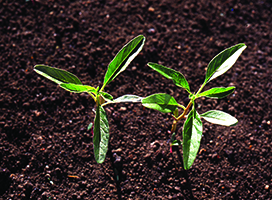 While there are dozens of common weeds that threaten yield each season, many Midwest corn growers often face off against waterhemp.
While there are dozens of common weeds that threaten yield each season, many Midwest corn growers often face off against waterhemp.
This demanding weed is leading the conversation and building strength against herbicides. It’s crucial to scout diligently, implement a diverse action plan and use a program herbicide approach with multiple modes of action to combat increasingly resistant waterhemp and other common broadleaf weeds.
New cases of resistant waterhemp are daunting to those in the ag industry, because it threatens the already-delicate ROI ratio, but waterhemp can grow stronger each year. We have to stay aggressive at reducing the waterhemp seedbank to protect fall yield and get a head start on next season.
Here are five tips to help you manage waterhemp and to limit additional resistance development:
- Scout diligently. Identify waterhemp early and continue to check your fields throughout the season. Ongoing scouting can help you plan timely postemergence herbicide applications and identify potential problem fields for the next year. It can be difficult to identify waterhemp in early growth stages because it looks similar to Palmer amaranth and other pigweed species. Waterhemp leaves are generally longer and more lance-shaped than other pigweeds.
- Layer residual herbicides. Layering residual herbicides keeps fields clean longer, typically through crop canopy closure, and manages the waterhemp seedbank. In corn, you can apply three unique modes of action with SureStart® II herbicide preemergence followed by an additional unique mode of action from Resicore® herbicide early postemergence.
- Plant narrower rows. Narrow row spacing can help suppress waterhemp growth by allowing crops to reach canopy closure quicker. Also, tillage is an enemy of waterhemp. Tillage can help lower waterhemp populations, because the seeds must germinate in the top part of the soil. However, tillage may not be a viable method of control on land prone to erosion.
- Prevent weeds from going to seed. Just a few waterhemp weeds left in a field can present significant problems for the next season. Waterhemp that goes to seed in corn or soybean fields can replenish the soil seedbank and potentially cross-pollinate with a population in another field and build additional resistance.
- Maximize application technology. Pay close attention to herbicide labels to maximize the efficacy of the product. Not every herbicide can be applied in the same manner with the same nozzles, water volumes, pressures and adjuvants. Waterhemp requires herbicide control and effective cultural practices, such as rotating crops, which should be planned for more than a single year at a time. When rotating crops, think beyond just rotating corn and soybeans to what you can do in that system. Rotating crops also allows farmers to rotate modes of action and adjust tillage plans for corn and soybean fields.
For more information about controlling waterhemp in corn, visit the Corn Herbicides Portfolio Page on Corteva.us.
1Heap, I. 2018. The International Survey of Herbicide Resistant Weeds. www.weedscience.org
™ ® Trademarks of Dow AgroSciences, DuPont or Pioneer, and their affiliated companies or their respective owners. Resicore and SureStart II are not registered for sale or use in all states. Resicore and SureStart II are not registered for sale, distribution or use in Nassau and Suffolk counties in the state of New York. Contact your state pesticide regulatory agency to determine if a product is registered for sale or use in your state. Always read and follow label directions. © 2019 Corteva.
The More You Grow
Find expert insights on agronomics, crop protection, farm operations and more.